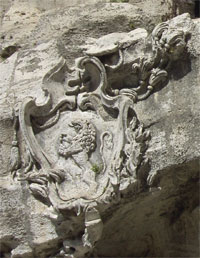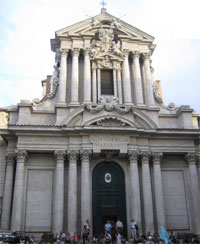There is a wild fig rooted in the top balaustrade; a capper is hanging on the Poli Palace façade cornering with Piazza dei Crociferi; a bush of mulleins; four ivy shoots; a prickly pear cactus; marsh marygold and lake reeds; an oak stumb below the statue of health; an artichoke; a vine with four bunches of grapes; a taro floating on water;a fig hiding below the jar; a cymbalaria on the right side facing via della stamperia; a group of evergreen plans by the end of the travertine rocks.There are also some animals: a snail lies on the marsh marygold and a lizard is hiding in a ravine of the walls. On the right side of the sea cliff there is the Coat of Arms of Monsignor Gian Galeazzo Caracciolo, President of the fountain project for some years. It features a lion and the particular type of hat of Papal Court prelates.The fountain is backed by the Poli Palace that belonged to the Conti Family dukes of Poli, a town in the Lazio Region. The palace was then inherited by the Sforza Cesarini family and then to the Boncompagni family until 1885 when the City Hall expropiated it.Today the palace houses the National Institute of Graphic Art.One of the roads leading to the fountain is Via delle Muratte. It takes its name from the Papal troops chief Renzo Musciani, nicknamed Amoratto, that used to live there in the renaissance.The church facing the fountain is the Church of SS Vincent and Anastasius. It was completed in 1650 by architect Martino Longhi the Younger and located in close proximity to the Quirinal Palace, for which it served as parish church. It is notable as the place where the precordia and embalmed hearts of 25 popes from Sixtus V to Leo XIII are preserved.Originally Roman Catholic, since 2002 the church has been used by the Saints Cyril and Methodius Bulgarian Orthodox parish in Rome. The façade features 18 columns so that it earns the nickname of Reed Bed.Another street leading to the fountain is Via del Lavatore . It takes its name from the Lavatore del Papa, a fountain with a large basin used to wash cloths - as a public laundry - located by the walls of the Papal Residence of the Quirinal Hill. continues... |
Grapes hanging on the fountain rocks
The Coat of Arms of Monsignor Caracciolo
The Church of SS. Vincent & Anastasius |
|---|



